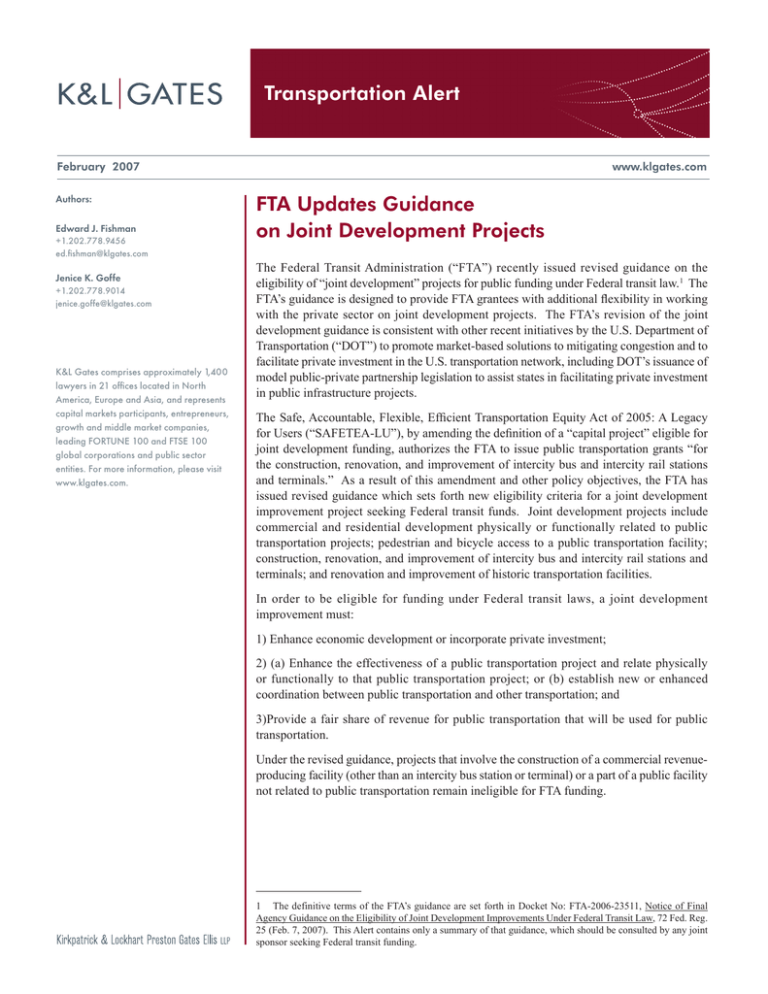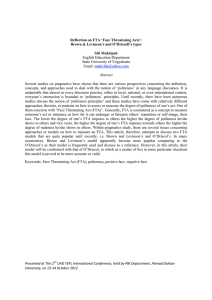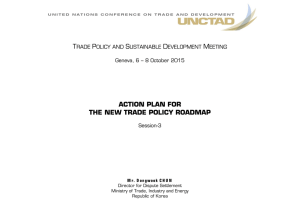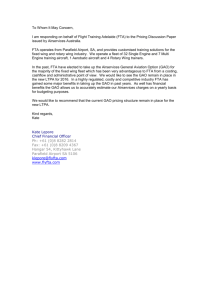
Transportation Alert
February 2007
Authors:
Edward J. Fishman
+1.202.778.9456
ed.fishman@klgates.com
Jenice K. Goffe
+1.202.778.9014
jenice.goffe@klgates.com
K&L Gates comprises approximately 1,400
lawyers in 21 offices located in North
America, Europe and Asia, and represents
capital markets participants, entrepreneurs,
growth and middle market companies,
leading FORTUNE 100 and FTSE 100
global corporations and public sector
entities. For more information, please visit
www.klgates.com.
www.klgates.com
FTA Updates Guidance
on Joint Development Projects
The Federal Transit Administration (“FTA”) recently issued revised guidance on the
eligibility of “joint development” projects for public funding under Federal transit law. The
FTA’s guidance is designed to provide FTA grantees with additional flexibility in working
with the private sector on joint development projects. The FTA’s revision of the joint
development guidance is consistent with other recent initiatives by the U.S. Department of
Transportation (“DOT”) to promote market-based solutions to mitigating congestion and to
facilitate private investment in the U.S. transportation network, including DOT’s issuance of
model public-private partnership legislation to assist states in facilitating private investment
in public infrastructure projects.
The Safe, Accountable, Flexible, Efficient Transportation Equity Act of 2005: A Legacy
for Users (“SAFETEA-LU”), by amending the definition of a “capital project” eligible for
joint development funding, authorizes the FTA to issue public transportation grants “for
the construction, renovation, and improvement of intercity bus and intercity rail stations
and terminals.” As a result of this amendment and other policy objectives, the FTA has
issued revised guidance which sets forth new eligibility criteria for a joint development
improvement project seeking Federal transit funds. Joint development projects include
commercial and residential development physically or functionally related to public
transportation projects; pedestrian and bicycle access to a public transportation facility;
construction, renovation, and improvement of intercity bus and intercity rail stations and
terminals; and renovation and improvement of historic transportation facilities.
In order to be eligible for funding under Federal transit laws, a joint development
improvement must:
1) Enhance economic development or incorporate private investment;
2) (a) Enhance the effectiveness of a public transportation project and relate physically
or functionally to that public transportation project; or (b) establish new or enhanced
coordination between public transportation and other transportation; and
3)Provide a fair share of revenue for public transportation that will be used for public
transportation.
Under the revised guidance, projects that involve the construction of a commercial revenueproducing facility (other than an intercity bus station or terminal) or a part of a public facility
not related to public transportation remain ineligible for FTA funding.
The definitive terms of the FTA’s guidance are set forth in Docket No: FTA-2006-23511, Notice of Final
Agency Guidance on the Eligibility of Joint Development Improvements Under Federal Transit Law, 72 Fed. Reg.
25 (Feb. 7, 2007). This Alert contains only a summary of that guidance, which should be consulted by any joint
sponsor seeking Federal transit funding.
Transportation Alert
Some of the more significant eligibility provisions set
forth in the revised guidance are highlighted below:
•“Incorporates Private Investment”
Private investments in eligible joint
development improvements may take the
form of cash, real property, or other benefits
generated initially or over the life of the joint
development improvement. The FTA has not
established a monetary threshold for private
investment, but instead will defer generally
to the amount and form of private investment
negotiated by the parties involved.
•“Physically Related”
A joint development improvement is
“physically related” to a public transportation
project if it provides a direct physical
connection to public transportation services or
facilities. Examples of physical relationships
include projects built within or adjacent to
public transportation facilities and projects
using air rights over public transportation
facilities.
•“Functionally Related”
A joint development is “functionally
related” to a public transportation project
if by activity and use, with or without a
direct physical connection, it: (i) enhances
the use of, connectivity with or access to
public transportation; or (ii) provides a
transportation-related service (such as remote
baggage handling or shared ticketing) or
community services (such as daycare or health
care).
•“Other Transportation”
For the purposes of determining whether there
is enhancement between public transportation
and other transportation, the concept of “other
transportation” includes airplanes, school
or charter buses, automobiles, taxicabs and
bicycles.
•“Provides for a Fair Share of Revenue for
Public Transportation That Will Be Used
for Public Transportation”
The FTA guidance specifies that the
determination of what is a fair share of
revenue and what form it should take shall
be negotiated between the parties involved in
the joint development improvement. After a
reasonable investigation, the recipient’s Board
of Directors shall determine whether the
terms and conditions of the joint development
improvement are commercially reasonable
and fair to the recipient and that such revenue
shall be used for public transportation. The
FTA will defer to such a determination.
A joint development improvement must be approved
by the FTA Regional Administrator responsible for the
project sponsor’s locality in order to become eligible
for FTA funding. Only FTA grantees may sponsor
a joint development improvement. FTA approval is
contingent upon the project sponsor certifying that
the joint development improvement conforms to the
criteria discussed above and that the project conforms
to the common grant rule. There is no limit on the
number of proposals that may be approved as FTA
Regional Administrators have the authority to approve
all proposals that meet the described criteria.
Only certain costs related to a joint development
improvement pursuant to a budget contained in an
approved grant are eligible for Federal transit funding.
Eligible costs for joint development improvements
may include: real estate acquisition, site preparation,
utilities, transportation-related FFE (furniture, fixtures
and equipment), parking and professional services. The
FTA’s existing third-party contracting requirements
apply to the federally funded construction aspects of
joint development. In addition, there are numerous
FTA cross-cutting requirements that are likely to
apply to joint development projects. One of the most
significant changes set forth in the revised guidance is
the FTA’s abandonment of the “highest and best transit
use” test for determining the value of real property
used in FTA-funded joint development improvements.
Instead of this vague standard, the
February 2007 | Transportation Alert
FTA will rely on the project sponsor to determine
the appropriate use and disposition of real property
in joint development improvements, as long as such
disposition and use complies with other applicable
statutes and FTA regulations. Overall, the FTA’s revised
joint development guidance provides public transit
agencies with a greater ability to attract private sector
investment in public transportation projects funded
with FTA monies. Although the FTA guidance did not
adopt certain approaches advocated by those in favor
of increased private investment, the FTA’s intention
to rely on the judgment of the project sponsor and the
discipline of the market in determining the appropriate
amount and terms of private sector investment should
help facilitate further private investment in FTAsponsored projects.
K&L Gates comprises multiple affiliated partnerships: a limited liability partnership with the full name Kirkpatrick & Lockhart Preston Gates Ellis LLP qualified
in Delaware and maintaining offices throughout the U.S., in Berlin, and in Beijing (Kirkpatrick & Lockhart Preston Gates Ellis LLP Beijing Representative
Office); a limited liability partnership (also named Kirkpatrick & Lockhart Preston Gates Ellis LLP) incorporated in England and maintaining our London
office; a Taiwan general partnership (Kirkpatrick & Lockhart Preston Gates Ellis) which practices from our Taipei office; and a Hong Kong general
partnership (Kirkpatrick & Lockhart Preston Gates Ellis, Solicitors) which practices from our Hong Kong office. K&L Gates maintains appropriate registrations
in the jurisdictions in which its offices are located. A list of the partners in each entity is available for inspection at any K&L Gates office.
This publication/newsletter is for informational purposes and does not contain or convey legal advice. The information herein should not be used or relied
upon in regard to any particular facts or circumstances without first consulting a lawyer.
Data Protection Act 1998—We may contact you from time to time with information on Kirkpatrick & Lockhart Preston Gates Ellis LLP seminars and with our
regular newsletters, which may be of interest to you. We will not provide your details to any third parties. Please e-mail london@klgates.com if you would
prefer not to receive this information.
©1996-2007 Kirkpatrick & Lockhart Preston Gates Ellis LLP. All Rights Reserved.
February 2007 |




